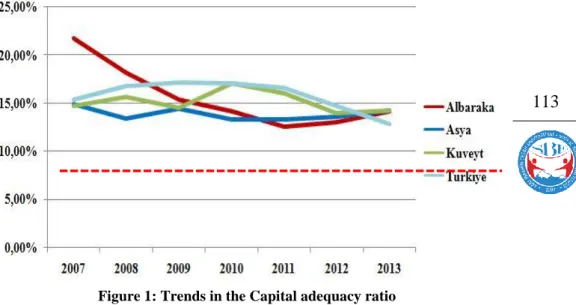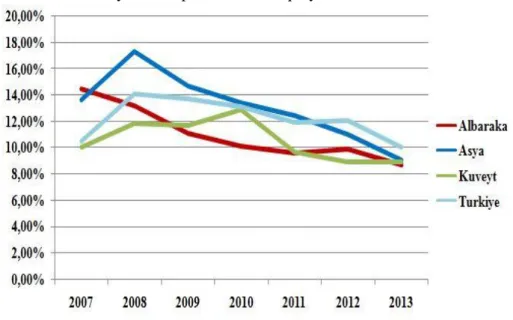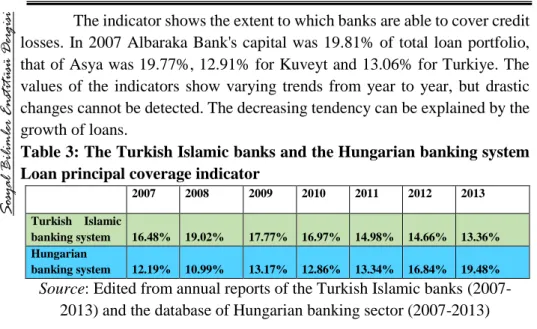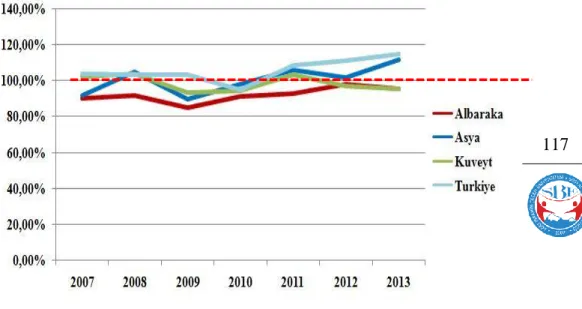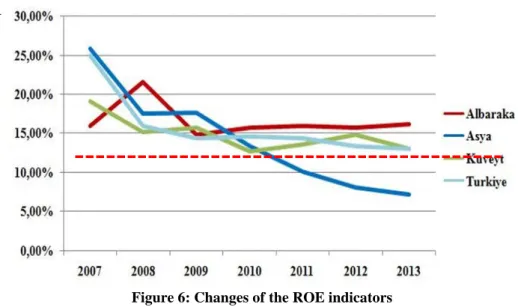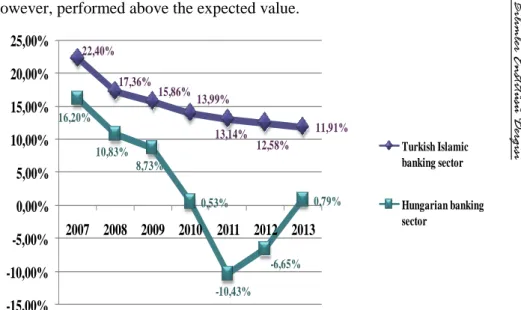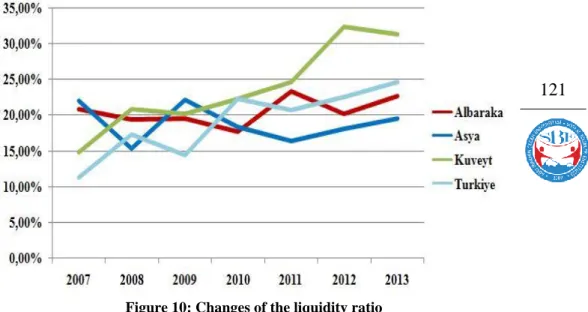THE COMPREHENSIVE ANALYSIS OF THE TURKISH ISLAMIC BANKING SYSTEM AND THE HUNGARIAN BANKING SYSTEM
Türk İslami Bankacılık Sisteminin Kapsamlı Bir Analizi ve Macar Bankacılık Sistemi
József Varga - Lívia Tálos
Abstract
The global economic crisis in 2008 has shaken the confident in conventional banks, and the eye of the world turned to the alternative financial technics. Islamic banks have largely survived the global economic crisis intact and they have offered a safer operation than conventional banks.
After the outbreak of the crisis the focus ison‘interest-free’ Islamic banks. These banks have not got "toxic" assets than traditional banks, the loans are not converted into securities, and does not assume high risk commercial transactions, nor speculate. After that, conventional banks have started operate Islamic departments, these sections are called Islamic windows. (Annual report of TKBB, 2009) Following the 2008 crisis increased the demand for Islamic financial products, and this led conventional banks to open Islamic division of their line. (Gálosi, 2010)
Keywords: Banking System, Turkish, Economic Özet
Bu çalışma Türk İslami bankacılık sisteminin analiz etmeyi ve onu Macar bankacılık sistemiyle karşılaştırmayı amaçlamaktadır. 2008 yılındaki küresel ekonomik kriz geleneksel bankalara olan güveni sarsmış ve dünya alternatif finansal tekniklere yönelmiştir. İslami bankalar küresel krizin etkilerinden kurtulmayı başarabilmiş ve geleneksel bankalara göre daha güvenli işlemler sağlamışlardır. Krizin patlak vermesinden sonra faizsiz İslami bankacılık odak noktası haline gelmiştir. Bu bankalar geleneksel bankalara kıyasla 'zehirli' kazanç sağlamamaktadırlar, krediler ipoteğe dönüştürülmez, ve spekülatif veya yüksek riskli ticari transferler yapılmaz. Bundan sonra geleneksel bankalar da İslami bölümler açmışlardır; bu bölümler 'İslami pencereler' diye adlandırılırlar (TKBB Yıllık Raporu , 2009).
Associate Professor Dr. Kaposvár University, Kaposvár, Hungary, varga.jozsef@ke.hu
So sya l B il iml er Ens ti tüsü D er gi si
112
2008 krizinin ardından İslami finansal ürünlere olan talep artmış bu da geleneksel bankaların İslami bölümler açmalarına yol açmıştır (Gálosi, 2010).
Anahtar Kelimeler: Bankacılık Sistemi, Türk, Ekonomi 1. Some words about Islamic finance
Islamic banking is a banking system that is based on the principles of sharia. The financial activities based on the five pillars of sharia. The most important concept is that both the charging and the receiving of interest or riba is forbidden. The next pillar is zakat. It means the giving of benefits to the poor. (Balázs, 2011) (Pálfi, 2010)
Gharar, speculation or forbid high risk is also one of the five pillars. The Islamic bank system looks at risk as a natural part of the business life, but transactions with great risk have to be avoided. (Bajkó et al, 2013)
The fourth is forbidden some transactions like gambling, and finally, Profit-Loss Share (PLS) which means partner-based relationship among the participants. Participants share the profit and the losses. (Balázs, 2011) (Pálfi, 2010)
2. The comparative analysis
Turkey's banking system consists of 49 banks, four of them operate according to the Islamic principles. Albaraka Turk Participation Bank Inc., Asya Participation Bank Inc., Kuveyt Turk Participation Bank Inc. and Turkiye Finance Participation Bank Inc. are the Islamic banks in Turkey. (Annual report of TKBB, 2014)
In the analysis a variety of indicators were calculated based on data from the annual reports. I focus only on the key solvency, profitability and liquidity indicators. Then, the results of the Turkish Islamic banking system were compared to the Hungarian banking system by highlighting the main indicators. Both of the banking sector's weighted average was calculated according to total assets.
The annual reports of the Turkish Islamic banks were used in English and Turkish language the period between 2007 and 2013. The annual reports downloaded from the banks’ website on the Internet. The Hungarian banking system’s data isavailable on the website of the Hungarian National Bank, the Banking sector data sources. (2007-2013)
The bank’s equity shows the strength of a bank and it is a major indicator of prudence. The main task of the Capital adequacy ratio (CAR) is maintaining the bank's long-term solvency. The indicator expressing
113
So sya l B ili ml er Ens tit üsü D erg isi113
113
solvency is used worldwide. The value of the index should be at least 8% in accordance with Basel standards. What is more, the integration under the Basel III directive does not spare all the antecedents since Saria has been already introdanced as a source of law, the so-colled Saria judiciariaries were inducted (Islamic Sharia Council) in Great Britain. This was a result of the fact that the arcbishop of Canterbury saw the tendency clearly in 2008 that Europe is aging, the demografic balance leans toward the Muslims, therefore the question is relevant: Is is possible to integrate Islam into the European democracies' structure? Another question is whether is is possible to integrate Islamic banks under Basel standards? (Cseh, 2014)
Changes in Capital adequacy ratios are shown in the graph below; the data come from the Turkish Islamic banks' annual reports.
Figure 1: Trends in the Capital adequacy ratio
Source: Edited from annual reports of the Turkish Islamic banks (2007-2013)
The data show that in the examined years all banks met the 8% criteria (----) morever, they reached even higher than that. Turkiye Bank had the highest Capital adequacy ratio in the examined years, but the other banks’ results were also close to this value. As each bank’s results were above the desired value, I regard the development of Capital adequacy ratios as good.
So sya l B il iml er Ens ti tüsü D er gi si
114
Table 1: Changes of the Turkish Islamic banks and the Hungarian banking sector's Capital adequacy indexes
2007 2008 2009 2010 2011 2012 2013 Turkish Islamic banking system 16.29 % 15.71 % 15.35 % 15.24 % 14.68 % 13.89 % 13.85 % Hungarian banking system 11.60 % 11.24 % 13.12 % 13.00 % 13.00 % 15.80 % 17.40 % Source: Edited from annual reports of the Turkish Islamic banks (2007-2013) and from the database of the Hungarian banking sector (2007-2013)
Table 1 shows the CAR indicators of the Turkish Islamic and the Hungarian banking systems. From the table it can be seen that both of the banking systems exceed the requirement, but the Islamic banks show better results for the first five years. Presumably, where the indicator increased, it was due to the increase of capital.
The following chart show the Leverage ratio. The results of the index were calculated by the comperison of the equity and total assets of the banks.
Figure 2: Changes in the Leverage ratio
Source: Edited from the annual reports of the Turkish Islamic banks (2007-2013)
The indicator also provides information about the bank's prudence, namely the distribution of equity and debt. The indicator can be interpreted that in 2007 Albaraka Bank’s equity accounted for 14.47% of foreign funds, then the index fell. In the case of Asya it was 13.63%, in the case of Kuveyt it was 10.04%,
115
So sya l B ili ml er Ens tit üsü D erg isi115
115
and 10.46% in the case of Turkiye. The reductions of the indicators suggest that the equity ratio increased. Banks mostly manage foreign resources so a high leverage is typical. In this case, following the crisis the change was a decline.
Table 2: The Turkish Islamic banks and the Hungarian banking system Leverage indexes 2007 2008 2009 2010 2011 2012 2013 Turkish Islamic banking system 12.16% 14.44% 13.14% 12.59% 11.04% 10.50% 9.20% Hungarian banking system 8.22% 7.49% 8.26% 8.26% 8.10% 9.38% 10.46%
Source: Edited from annual reports of the Turkish Islamic banks (2007-2013) and from the database of the Hungarian banking sector (2007-(2007-2013) In terms of the investigation of bank prudence the Hungarian banking system was well below the values of the Turkish values, except in 2013; so we can say the Turkish banks' Leverage ratio improved, thus they are safer.
The main activity of the banks is lending. It is important to monitor the degree of credit losses througout this activity, i.e. how they are capable to cover the losses. This is shown by Loan principal coverage indicator.
Figure 3: Changes of Loan principal coverage indicator
So sya l B il iml er Ens ti tüsü D er gi si
116
The indicator shows the extent to which banks are able to cover credit losses. In 2007 Albaraka Bank's capital was 19.81% of total loan portfolio, that of Asya was 19.77%, 12.91% for Kuveyt and 13.06% for Turkiye. The values of the indicators show varying trends from year to year, but drastic changes cannot be detected. The decreasing tendency can be explained by the growth of loans.
Table 3: The Turkish Islamic banks and the Hungarian banking system Loan principal coverage indicator
2007 2008 2009 2010 2011 2012 2013
Turkish Islamic
banking system 16.48% 19.02% 17.77% 16.97% 14.98% 14.66% 13.36% Hungarian
banking system 12.19% 10.99% 13.17% 12.86% 13.34% 16.84% 19.48% Source: Edited from annual reports of the Turkish Islamic banks
(2007-2013) and the database of Hungarian banking sector (2007-(2007-2013) Comparing the two banking sector’s data the Turkish Islamic banks performed better values again until 2012, namely the Islamic banks' own capital provides more prudence than that of traditional banks.
The total assets of Turkish banks increased year by year. The most significant asset is VI. Loans and receivables, namely loans. The lending activity has not slowed down; the banks lent more and more each year.
74,71% 75,83% 74,22% 74,24% 73,51% 71,51%69,12% 67,44% 68,12% 62,75% 64,20% 60,74% 55,68% 53,69% 0,00% 10,00% 20,00% 30,00% 40,00% 50,00% 60,00% 70,00% 80,00% 2007 2008 2009 2010 2011 2012 2013 Turkish Islamic banking sector Hungarian banking sector
Figure 4: Changes of the Turkish Islamic banks and the Hungarian banking sector's loan portfolio
Source: Edited from Annual reports of the Turkish Islamic banks (2007-2013) and the database of the Hungarian banking sector (2007-2013)
117
So sya l B ili ml er Ens tit üsü D erg isi117
117
More than 70% of the consolidated assets of the Turkish banking sector is loans. However, the value has been decreasing year by year in both of the banking sectors, i.e. the assets of other items, in this case the ratio of liquid assets (such as cash and Central Bank deposits, securities, interbank deposits) have increased in total assets. According to the data of Hungarian banking sector in 2012 and in 2013 values of the index are 56% and 54%, which means that credits make up half of the assets.
The Banks’ business policy indicated by the Loan / Deposit ratio.
Figure 5: Change in the loan / deposit ratio
Source: Edited from annual reports of the Turkish Islamic banks (2007-2013)
In the years between 2011-2013 and in 2008 the index was 100% (--) that is above the healthy limit, which meant that the Islamic banks were on aggressive business policies, that is the size of the loans exceeded the value of deposits, which has been a liquidity risk.
So sya l B il iml er Ens ti tüsü D er gi si
118
Table 4: The Turkish Islamic banks and the Hungarian banking sector's Loan / Deposit ratio
2007 2008 2009 2010 2011 2012 2013
Turkish Islamic banking system 97.23% 101.98% 93.10% 95.16% 103.56% 102.38% 105.38% Hungarian banking system 152.98% 162.72% 152.43% 155.79% 143.74% 118.76% 110.37%
Source: Edited from annual reports of the Turkish Islamic banks (2007-2013) and from the database of Hungarian banking sector (2007-(2007-2013) In this area, the value of the Hungarian banking sector exceeded the criteria of 100% from 2012 onwards, however, it began to decline, which is explained by a drop in lending activity.
Return on equity (ROE) and Return on assets (ROA) are commonly used indicators of profitability.
Figure 6: Changes of the ROE indicators
Source: Edited from annual reports of the Turkish Islamic banks (2007-2013)
ROE answers how the equity produces profit. In case of banks a healthy ROE is around 10-12% (----). This indicator did not depict a negative value, because there was not negative profit after tax. Markedly the
119
So sya l B ili ml er Ens tit üsü D erg isi119
119
profitability of the Bank Asya decreased significantly and steadily from 2009, which can be explained by the decrease of net result. The other banks, however, performed above the expected value.
22,40% 17,36% 15,86% 13,99% 13,14% 12,58% 11,91% 16,20% 10,83% 8,73% 0,53% -10,43% -6,65% 0,79% -15,00% -10,00% -5,00% 0,00% 5,00% 10,00% 15,00% 20,00% 25,00% 2007 2008 2009 2010 2011 2012 2013 Turkish Islamic banking sector Hungarian banking sector
Figure 7: The Turkish Islamic banks and the Hungarian banking sector's ROE indicators
Source: Edited from Annual reports of the Turkish Islamic banks (2007-2013) and the database of the Hungarian banking sector (2007-2013)
The profitability of the Hungarian banking sector remained well below the profitability of Turkish banks and even added negative value in 2011 and in 2012, which means that the banking sector was making a loss. The profitability of the Turkish banking sector shows a decreasing tendency, but there was not a negative result.
So sya l B il iml er Ens ti tüsü D er gi si
120
Figure 8: Changes of the ROA indicator
Source: Edited from annual reports of the Turkish Islamic banks (2007-2013)
The ROA gives us data about banks’assets. It shows how the good placements of banks and the effectiveness of banks' placements are. The value of the index between 1 and 2 (----) is estimated to be good. The decline of the indexes reflects the deterioration in the banks' recovery. From 2009 a downward trend can be observed. The downward trend in ROA is typical, but it is still within the limits.
17,31% 17,88% 19,27% 20,12% 20,95% 23,46% 24,62% 16,80% 13,52% 19,70% 28,51% 30,62% 35,85% 37,57% 0,00% 5,00% 10,00% 15,00% 20,00% 25,00% 30,00% 35,00% 40,00% 2007 2008 2009 2010 2011 2012 2013 Turkish Islamic banking sector Hungarian banking sector
Figure 9: The Turkish Islamic banks and the Hungarian banking sector's ROA indicators
Source: Edited from Annual reports of the Turkish Islamic banks (2007-2013) and the database of the Hungarian banking sector (2007-(2007-2013)
121
So sya l B ili ml er Ens tit üsü D erg isi121
121
Comparing the two banking systems the Turkish banking system has better values than the Hungarian banking system, and in the case of Hungarian banks due to the negative net result the indicator has negative values in 2011 and in 2012. As a consequence of the crisis the profitability of the Hungarian banking sector has changed considerably. The developement of profitability indicators in the case of Hungarian banking sector is likely to have been influenced by the bank tax and the problems caused by the FX-based loans.
The Liquidity indicator informs you to what extent it can meet its short term liabilities with short term assets. The higher the index value the more liquid a bank can be considered. Liquid assets include I. Cash and deposit accounts in the Central Bank, III. Interbank deposits, as well as the V. Financial assets for sale.
Figure 10: Changes of the liquidity ratio
Source: Edited from annual reports of the Turkish Islamic banks (2007-2013)
We get a fluctuating picture of the changes of the liquidity of individual banks. The increase and decrease in liquidity may be justified by the changes of banks' liquid assets. In the case of Islamic banks the increase in liquidity can be explained by the rise in Cash and Central Bank accounts.
So sya l B il iml er Ens ti tüsü D er gi si
122
Table 5: The Turkish Islamic banks and the Hungarian banking system liquidity indicator 2007 2008 2009 2010 2011 2012 2013 Turkish Islamic banking system 17.31 % 17.88 % 19.27 % 20.12 % 20.95 % 23.46 % 24.62 % Hungarian banking system 16.80 % 13.52 % 19.70 % 28.51 % 30.62 % 35.85 % 37.57 % Source: Edited from annual reports of the Turkish Islamic banks
(2007-2013) and from the database of Hungarian banking sector (2007-(2007-2013) The Hungarian banking sector's liquidity has been higher than that of the Turkish Islamic banks since 2009. Probably Hungarian banks began to buy government bonds, and the money was kept in them. Overall, both of the banking systems endeavored to perform its payment obligations and to maintain appropriate liquid assets.
3. Summary
After the 2008 economic crisis, special attention was given to alternative financing techniques, and so Islamic banks. During the crisis the stability of the Islamic banks was higher than the stability of the conventional banks.
The major source of revenue of the conventional banks is interest and other income from speculative transactions, so a conventional bank can show higher results than an Islamic bank. Islamic banks operate on religious principle, so many activities are forbidden to them, but nonetheless they can achieve profit and become operational.
In the case of the Turkish Islamic banking sector the following conclusions can be made after examination of the datas. The stability of the banks' was not at risk, Capital adequacy is satisfactory. The profitability deteriorated, but not significantly. The liquidity crisis has been highlighted in the outbreak, but for Turkish banks to maintain liquidity remained. The liquidity can be said appropriate, as banks sought to have sufficient amount of liquid assets.
The Turkish Islamic banking system have not caused a drastic decline or negative results in terms of the global economy occurring adverse events. Perhaps, due to the fact that Islamic banks have not assumed a higher risk before the crisis, it did not make the banking system vulnerable to the economic downturn.
123
So sya l B ili ml er Ens tit üsü D erg isi123
123
Sonuç2008 yılındaki ekonomik krizden sonra alternatif finans tekniklerine ve İslami bankalara özel bir önem verilmiştir. Kriz süresince İslami bankaların istikrarı geleneksel bankalarınkinden daha yüksekti. Geleneksel bankaların en büyük gelir kaynağı faizler ve spekülatif para transferleridir; bu nedenle bir geleneksel banka İslami bankadan daha yüksek değerler vermektedir. İslami bankalar dini referanslarla çalışmaktadırlar; bu nedenle pek çok etkinlik onlar için yasaklıdır ancak yine de operasyonel olup kar edebilirler. Veri analizi sonucunda Türkiye'deki İslami bankacılık sektörü için aşağıdaki sonuçlara ulaşılabilir. Bankaların istikrarı risk altında değildi, anapara miktarı yeterlidir. Kar edebilirlik düşmüştür ama bu ciddi bir düşüş değildir. Nakit krizi, küresel kriz patladığında ciddi düzeydeydi ancak Türk bankaları nakit oranını koruyabildiler. Bankalar yeterli miktarda nakitleri olduğu bilindiğinden nakit miktarının yeterli olduğu söylenebilir. Türk İslami bankacılık sistemi küresel ekonominin olumsuz etkileri açısından ciddi bir düşüş veya olumsuz sonuç yaşamamıştır. Muhtemelen, İslami bankaların krizden önce yüksek risk görmemesi nedeniyle bu kriz bankacılık sistemini ekonomik gerilemeye maruz hale getirmemiştir.
References
Attila Bajkó, József Varga, Gábor Sárdi: RISE OF THE ISLAMIC BANKING SECTOR In: Szendrő Katalin, Soós Mihály (szerk.) Proceedings of the 4th International Conference of Economic Sciences. Konferencia helye, ideje: Kaposvár, Magyarország, 2013.05.09-2013.05.10. Kaposvár: Kaposvár University, pp.:302-312.
Balázs J. (2011): Az iszlám bankrendszer: Tanulságok a neoliberális pénzügypolitika figyelmébe, Valóság, 2011. 54. évf. 1.sz., pp.: 1-11
Cseh, B. (2014): A tradicionális vallási jog és a kodifikált állami jog együttélése. Az iszlám és a germán jogi kultúra a német területeken élő muszlim közösségekben, In: Drinóczi, T., Naszladi, G., Novák, B. (szerk.) Studia Iuvenum Iurisperitorum, 2014, Pécs pp.15-35. Gálosi M. B.(2010): Iszlám ablak – ablak az iszlámra, Budapesti Corvinus
Egyetem, szakdolgozat
Pálfi G. (2010): Iszlám finanszírozás a pénzügyi piacokon, Fordulat, 11.sz., 2010 http://fordulat.net/pdf/11/F11_Palfi-finance.pdf letöltés: 2015. augusztus 25.
So sya l B il iml er Ens ti tüsü D er gi si
124
Annual reports:Database of Hungarian banking sector (2007-2013), MNB: http://alk.mnb.hu/intezmenyeknek/hitelintezetek/publikaciok Downloaded: 2015.11.02.
Annual reports of Bank Albaraka 2007-2013:
http://en.albarakaturk.com.tr/investor_relations/detail.aspx?SectionID=Dr8C w16dHGqYzoMeqx%2fjjQ%3d%3d&ContentID=4oEu6KjEm U33gGZTiL4GkQ%3d%3d
http://www.albarakaturk.com.tr/faaliyet-raporlari.aspx Downloaded: 2015.08.25.
Annual reports of Bank Asya 2007-2013:
http://www.bankasya.com.tr/en/investor-relations-annual-reports.aspx Downloaded: 2015.08.25.
Annual reports of Bank Kuveyt 2007-2013:
http://www.kuveytturk.com.tr/financial_information.aspxhttp://www.kuveytt urk.com.tr/finansal_bilgiler_hakkimizda.aspx
Downloaded: 2015.08.25.
Annual reports of Bank Turkiye 2007-2013::
http://www.turkiyefinans.com.tr/en-us/investor-relations/financial-data-and-reports/Pages/annual-reports.aspx
http://www.turkiyefinans.com.tr/tr-tr/yatirimci-iliskileri/finansal-raporlar/Sayfalar/bagimsiz-denetim-raporlari.aspx Downloaded: 2015.08.25.
Annula reports of Participation Banks Association of Turkey:
http://www.tkbb.org.tr/research-and-publications-tkbb-publications-annual-sector-reports
